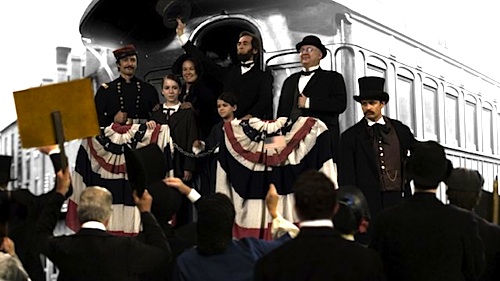By Joe Bendel. Ward Hill Lamon was a Southerner who opposed slavery. He was a lawyer, who packed a mean banjo and a plenty of guns. Before the creation of the Secret Service, he was a handy man for Lincoln to have around. The odd couple friendship between the president and his self-appointed but Federally-empowered bodyguard is dramatized in Salvador Litvak’s Saving Lincoln, which opens this Friday in New York.
As he explains in medias res to some of Lincoln’s rather disappointed supporters, Lamon was not at the Ford Theater on that fateful night. He was serving as a special Reconstruction envoy down south. Via flashbacks, we watch their whole story unfold. Both men shared a love of song that brought them together as friends and law partners. During the dark days of the Civil War, Lamon often raises Lincoln’s spirits with a hill country folk tune, like “Old Dan Tucker.” He also finds that foiling assassination attempts is a full time endeavor.
While not as epic as the Oscar favorite turned underdog, Saving Lincoln largely ignores (or spares) the less than edifying rhetoric of the rival Democratic Party, but conveys all the virulent invective flowing from the press (which were essentially one and the same, even then). However, the real eye-opener of Saving Lincoln is the sheer volume and increasing audacity of the attempts made on Lincoln’s life. Indeed, there are enough assassination bids to build a film around, which is essentially what Litvak has done.

Stylistically, Saving Lincoln is also something else entirely. Shot entirely on a green-key soundstage, Litvak incorporated vintage era photographs into the CGI backdrop, creating the impression of Matthew Brady pictures come to life. Although not as artistically rendered, the nearest comparison might be Lech Majewski’s genre-defying The Mill & the Cross. While initially it looks a little weird (particularly in less stately settings, oddly enough), it is far less distracting over time than the high frame rate of Jackson’s Hobbit. In fact, the approach works quite well in big, momentous scenes, most notably including the Gettysburg Address.
Illinois’ own Tom Amandes is a bit short perhaps, but otherwise a good physical likeness as Lincoln. More importantly, he is quite good at tapping into the iconic president’s deep reservoirs of humility and humanity. This is a surprisingly touching performance. In contrast, Lea Coco’s work is rather mannered as Lamon. Yes, he is a Southerner and Coco is not about to let us forget it. Still, Penelope Ann Miller’s turn as Mary Todd Lincoln clearly suggests she is high strung, but in a nuanced rather than caricatured way.
From giving Sen. Ned Baker (Republican of Oregon) his due as a longtime Lincoln confidant and the only member of Congress to fall in battle as a uniformed officer, to exploring the role the 16th President’s Christian faith played in his life and opposition to slavery, Saving Lincoln is a worthy addition to the growing Lincoln film canon. It successfully evokes the look and feel of the Civil War era through its green screen effects and it is supported by a very fine lead performance from Amandes. Recommended for Presidents’ Day viewing, Saving Lincoln opens this Friday (2/15) in New York at the Quad Cinema.
LFM GRADE: B
Posted on February 12th, 2013 at 1:42pm.